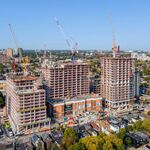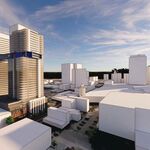Would there be substantial savings if a trench was dug and just decking over it with some shrubs and greenery? I think most people would be all for this actually, it would create quite a nice boulevard feel on Eglinton I'd imagine.
The savings would come from not having to equip the line with ventilation and expensive emergency exit tunnels (the EE's would just be a set of metal stairs every x metres). Stations would need to be partially underground, but because of track depth, they wouldn't be double-levelled stations. Think Dundas Station, only right beyond the end of the platform it would become open air.
And yes, the boulevard effect could be quite nice in certain spots. I would imagine that at stations especially having them decked over would be nice and would have a double benefit (nicer street presence, and covered platforms). Of course, the decked sections should be short enough as to not require any ventilation. As soon as you start adding that the price jumps.
On a side note...I can't believe I'm the only person who really doesn't understand why so much emphasis is being put on the eastern section of the line. I would much rather have them go from Yonge all the way to Pearson, before they go east to Kennedy. I mean there is already an existing SRT (why don't they just repair that and leave provisions for an extension along eglinton towards Yonge in the future). People in scarborough already have a link downtown (bloor subway/ SRT link). Etobicoke and the west really, and especially the north-eastern part of Toronto could really benefit from an eglinton subway in the west that connects to Pearson. Pearson is a huge employer in the area (much more so than STC). Why is everyone obsessed with STC? Not to mention that Pearson stands to benefit from local connections just as much as longer connections (ARL). It also seems to be much more built up along eglinton in the West as opposed to the eastern portion.
I don't mean to come off as a douche or anything, I just really have a hard time understanding why there is so much emphasis on the STC area?
The emphasis on the eastern stretch of Eglinton is so high because putting that section at-grade, especially if the two lines are connected, could place a pretty severe choke point on the entire line. Think of it like a roadway where everyone is trying to get from Point A to Point F. If the road between Point A and Point C is 4 lanes in each direction, but from Point C to Point D is only 2 lanes, and then from Point D to Point F back to 4 lanes again, does it really matter that the majority of the road is 4 lanes? Not really. The capacity of the road in that case is limited to it's narrowest point.
This is the issue with Eglinton East. It doesn't matter that the tunnelled and elevated sections can support 3 car trains using ATC, if the at-grade section can only support 2 car trains. It effectively kills any possibility of increasing capacity further down the road.
As for the STC thing, it's not just a density hub, it's also a transit hub for the entire Eastern GTA, something that is only going to increase in importance with time. I agree that the line should be pushed as far west as possible right off the bat, but I also want to see it designed properly, something that the last western section plan was not.




